
For commercial carriers
Winter weather and icy road conditions can increase the chance of crashes and injuries. Every employer operating commercial vehicles needs to have a health and safety program that includes measures to help protect their employees who drive in winter. Learn more about winterizing your road safety procedures, and making sure your vehicles and drivers are prepared for winter.
Tips for employers
Winter is not business as usual. The number of crashes in BC increases when temperatures drop and snow, ice, rain, or fog hit. Trucks can spin out in as little as 1 cm of snow. When commercial vehicles crash or slide off the road, their size can make the consequences catastrophic.
As an employer or supervisor, you need to plan ahead and prepare with measures to reduce winter driving risks. Waiting until the season arrives is too late.
For commercial carriers, a crucial first step is to make sure you’re meeting your occupational road safety responsibilities. During winter, you need to pay particular attention to:
To prepare yourself for the season ahead, complete our Making Winter Driving Safer for Your Employees online course. Also have supervisors do the course.
Help prepare employees by providing relevant information and training. For example:
- Review winter driving procedures with your drivers so they’re familiar with requirements and practices.
- Check your risk assessment, focusing on winter driving hazards and the solutions.
- Talk with drivers about the specific hazards on the routes they will travel.
- Have a supervisor or trainer go for ride-alongs to orient new hires and drivers with limited winter experience.
- Have drivers review our winter driving tips in the section below, the For drivers section and the Driving for the Conditions Tool Kit.
- Use our winter driving tailgate meeting guides to share information with staff.
You need to understand BC’s commercial vehicle tire and chain requirements and have drivers follow them.
Commercial drivers who travel outside the Greater Vancouver and Greater Victoria areas in winter are required to carry chains or other acceptable traction devices. Throughout the province, drivers need to obey winter tire and chain signs from October 1 to April 30. For select highways not located through mountain passes and/or high snowfall areas, tire and chain requirements end March 31.
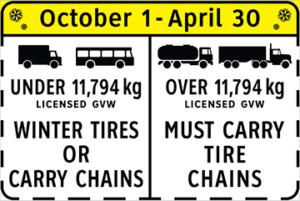
Commercial trucks weighing between 5,000 kg and 11,794 kg Licensed Gross Vehicle Weight (LGVW) must carry chains or acceptable traction devices, unless the vehicle is equipped with winter tires.
Commercial vehicles 11,794 kg LGVW and greater, such as tractor trailers, are required to carry steel chains on most major highways.
Doing that will not only reduce the likelihood of any of your employees being involved in a crash causing serious injuries, it can also help you:
- Identify and remedy unsafe vehicles, equipment or practices conditions before they cause costly downtime or contribute to a crash
- Dispatch drivers and vehicles more efficiently
- Reduce time at roadside inspections and avoid regulatory penalties
- Attract and retain safe and satisfied drivers
Tips for commercial drivers
Whether you’re a new driver or an experienced one, winter driving can be dangerous. Avoid driving during extreme weather and road conditions if possible. Have a conversation with your employer and ask for training and make sure you understand and follow your organization’s winter driving policy and procedures.
Check weather and road conditions on DriveBC.ca to help create a trip plan. Identify rest stops and chain-up areas along the way. Talk with your supervisor, dispatcher, and other drivers for information before heading out.
Review our section for winter drivers and these additional tips specifically for commercial driving:
Operating safe, reliable commercial vehicles becomes even more important in winter. In addition to the pre-trip inspections you conduct to comply with BC Motor Vehicle Act Regulation 37.22, during winter be sure to:
- Check tires to make sure they’re properly inflated and have plenty of tread.
- Check the condition of chains and make sure you know how to install them properly.
- Clean snow from the windows, hood, mirrors, headlights, taillights, and trailer.
- Make sure sensors for driver-assist systems are clean.
- Clean your windshield, inside and out.
- Check that the load is properly secured and balanced.
- Keep your diesel tanks full so you won’t run out if you’re delayed or get stuck.
- Make sure diesel is winter-grade or use an additive to prevent diesel from gelling when it gets cold.
- Put anti-gel additive in your tank before you fuel up, if you use it.
- Use amber fog lights to soften the glare.
- Point a fog light slightly toward the right, so you can use the snowbank or ditch line as a steady reference.
- Drive more cautiously (e.g., increase following distance) when bobtailing or driving with no load. There’s less weight on the rear axles, which means there’s greater risk of losing traction during hard braking or acceleration.
- Optimize traction whenever roads are slippery by making sure your load is properly balanced and distributed over all axles.
- Turn off retarders (e.g., engine brakes) whenever the road is slippery. Retarders may cause your truck to lose traction. The goal is to have even braking on all axles.
- Turn off cruise control in adverse weather.
- Plan for surprises. Continuously scan your surroundings and think of what you’ll do in different scenarios, such as wildlife crossing the road in front of you or your vehicle sliding as it enters a corner.
Pulling over on wintry roads can create a hazard for you and other drivers. Move well to the side of the road, into a pull-out or other wide spot. Activate your 4-way flashers. Place warning lights or reflective cones behind your vehicle in 6-foot increments. If you need to work at the roadside, either on your vehicle or as part of your job, know how to set up and take down a cone zone.
Be sure to wear a reflective vest or jacket when outside your vehicle. Carry a flashlight if daylight is fading.
In icy conditions, wear shoes or boots with good traction. Maintain 3 points of contact with your hands and feet when entering or exiting the cab.
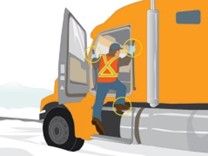
Traction and skids
Traction loss can occur anytime and anywhere especially if you are driving too fast for the conditions. The most common causes of traction loss are:
- Over-braking, which can lock up the wheels
- Over-steering, which can cause the back end of the vehicle to slide out
- Over-acceleration, which can cause the drive wheels to spin
- Entering a corner too fast
Here’s how you can keep traction and reduce the risk of skids:
Ensure your tires are properly inflated and have good tread depth. The legal minimum tread depth for passenger vehicles is 3.5 mm (5/32″). For winter driving, it’s better to have much more tread than that.
The tire ply, rating, and load all impact the manufacturer’s recommended inflation value. Visit a qualified commercial tire service centre to ensure your tires are inflated to the proper PSI.
Always have a load spread evenly from left to right. Make sure the load is secured and correctly distributed over the axles.
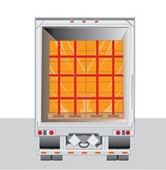
Conditions change. So should your speed. For example, when rain follows a nice sunny day, you need to slow down because oil rises to the top and makes the road slippery.
Generally, it’s best to avoid parking on any steep hill. Instead, select a location that’s flat. If you must park on a hill, follow these tips:
Facing uphill: Turn your front tires to the left, towards the centre of the road. This applies when there is a curb and when there isn’t one. It helps prevent the vehicle from rolling into traffic.
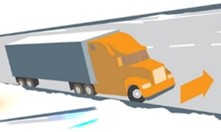
Facing downhill: Turn your front tires towards the curb or right shoulder. This helps prevent the vehicle from rolling into traffic.
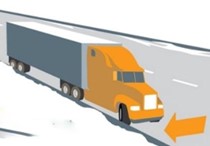
What to do in a skid
If you lose traction and start to skid or slide, the best way to recover control depends on the type of skid you’re in:
If drive axle tires are locking up:
- Engine brake is on: Turn off the Jake brake or reduce the number of heads applied until you recover traction.
- Only wheel brakes are on: Decrease or release pressure on the brake pedal.
- Jake and wheel brakes are on: Turn off the Jake brake or reduce the number of heads applied. If still skidding, decrease or release pressure on the brake pedal. If you must, release both the Jake and wheel brakes. Gently applying the trailer brakes can also help.
If tires on both drive and steering axles are skidding:
- Reduce or briefly release pressure on the brake pedal.
- If you are on ice, push in the clutch to let the wheels turn freely.
- Look and steer in the direction you want to go.
- Counter-steer as the vehicle recovers to avoid skidding in the opposite direction.
If tires on both drive and steering axles are skidding
- Reduce or briefly release pressure on the brake pedal
- If you are on ice, push in the clutch to let the wheels turn freely.
- Look and steer in the direction you want to go.
- Counter-steer as the vehicle recovers to avoid skidding in the opposite direction.
You can find all of these tips in our Get a Grip When Driving in Winter Conditions guide (PDF).
Chaining up
Commercial vehicles with a Licensed Gross Vehicle Weight (LGVW) between 5,000 kg and 11,794 kg need to carry chains or acceptable traction devices, unless the vehicle is equipped with winter-rated tires with the 3-peaked mountain and snowflake symbol or the M+S symbol.
Heavy commercial vehicles 11,794 kg LGVW and greater, such as tractor trailers, are required to carry steel chains on most major highways.
Drivers of heavy commercial vehicles are required to chain up when lights are flashing on chain-up signs or when overhead message signs specify a chain-up is in effect. The DriveBC website also shows routes where chain-up requirements are in place.
Failure to follow the requirements may result in your vehicle being turned back from its intended route and your driver being fined under the BC Motor Vehicle Act.
- Commercial vehicles over 11,794 kg must carry steel tire chains from October 1 to April 30 on most major highways.
- Make sure your chains are the right size for your tires.
- Follow the manufacturer’s written instructions.
- Discuss current road conditions and upcoming weather events with your dispatcher.
- Employers have a legal duty to provide instruction and training to keep you safe on the job. Learn how to safely install chains before you need them.
- To improve traction and vehicle control.
- For your safety and the safety of other road users.
- To reduce the risk of property damage.
- To keep you moving, and help prevent downtime.
- To avoid costly road closures.
- It’s the law: non-compliance can lead to a fine and penalty points.
- Don’t wait until it’s too late! If you think you might need chains, you probably do. If you see other drivers chaining up, there’s likely a good reason. Talk with other drivers to find out what’s ahead. Choose a safe location and chain up before you get into trouble.
- When lights are flashing on designated chain up routes.
- When overhead message signs specify chain up is in effect.
- When Government of BC websites and phone lines specify that chain up is in effect:
- DriveBC.ca/ChainUp.php
- DriveBC.ca
- Toll-free telephone access for road reports: 1-800-550-4997
- Not safe? Don’t go! If conditions are treacherous, you may be better off stopping and waiting for conditions to improve.
It’s smart to practice installing chains in good weather, rather than trying to install chains during a blizzard. Follow the manufacturer’s instructions and ask your supervisor for training.
- Stop in a designated chain up area if you can get there safely. If you can’t, find an accessible rest stop or pull-out. Avoid chaining up at the side of the road.
- Leave space between yourself and the truck in front — allow for movement.
- Secure your truck — apply the parking brake and turn off the engine.
- Activate hazard lights — make sure they’re working and clear of mud and snow.
- Use suitable non-slip wheel chocks to help secure the truck and trailer.
- Follow company health and safety policies and practices.
- Use three-points of contact (two hands and one foot, or two feet and one hand) and climb down from the cab slowly.
- Wear warm, waterproof, slip-resistant footwear and a compliant high-visibility garment.
- Have multiple sets of gloves, waterproof clothing and a small kneeling tarp.
- Use a headlamp at night or in low-light conditions.
- Get close to the tires to minimize overextending your reach.
- Stay balanced – keep feet at shoulder width when crouching.
- Adapt driving techniques to road and weather conditions.
- Don’t exceed speeds of 50 km/h.
- Avoid running chains on bare pavement, hitting curbs and spinning wheels.
- Listen and watch for loose chains – stop in a safe place to check chains, and adjust as necessary.
- Inspect chains after use – repair or replace when necessary.